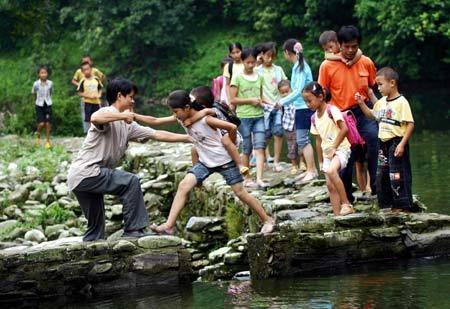X-3 Question: Education in rural areas is a major factor restraining China's reform. And, the difficulty and emphasis of China's education also lie in rural areas. What measures will China take to improve its education system in those areas?
A: China is a developing country with a population of 1.3 billion. It is not easy for China, a poor country to expand its education. China experienced a rapid economic growth in the past nearly 30 years and has become the world fourth largest economy. The key for China to sustain its economic growth is education. However, education in rural areas is a major factor restraining China's reform and development and the difficulty and emphasis of China's education also lie in rural areas. China's hope of rejuvenating its education is also in rural areas. Chinese Government has reached a consensus that China will become prosperous only after its rural areas becoming prosperous and China's education will become stronger only after education in rural areas becoming stronger.
China has a big population in its rural areas and a large number of people there need education. Statistics show that a total of 180 million students are currently receiving compulsory education in China, among whom, 148 million are in rural areas. Thus, education in rural areas is one of the largest social welfares in China's education system. In 1980s and 1990s, Chinese Government proposed that education system be supported and run by the people. In late 1990s and early 2000s, Chinese Government proposed that education be supported and run by the government, thus increasing the investment of several hundred billion yuan to education sector. This directly led to two climaxes of education development in China. As a result, the coverage of nine-year compulsory education and the program of basically eradicate young illiterates reached 93.6 percent. Meanwhile, the net enrollment ratio of school-age children in primary schools reached 98.95 percent and the gross ratio of that of junior middle school also hit 94.1 percent. The gender gap in primary school reduced to 0.04 percentage point. Given the fact that China has a population of 1.3 billion including 800 million rural people, we can clearly see the achievements China has made in education sector in the past years.
The year 2007 is an important year for China's compulsory education in rural areas. All the 148 million school-age children in primary and junior middle schools will not be charged by any fees, including tuition and incidental fees such as those on teaching materials, school uniform and health checkup. Chinese Government strictly prevents schools from charging other fees from students. Students from impoverished families do not have to pay for their textbooks and other books necessary for their study. Students living in dormitories built by government financial funds do not have to pay in principle and related fees will be allocated from schools' public funds
For this, China will increase 218.2 billion yuan of compulsory education funds to rural areas from 2006 to 2010. The reform will directly benefit each student of compulsory education by annually reducing the charge of 140 yuan from each primary school student and 180 yuan from each junior middle school students. The figures will be bigger for impoverished students. Because of the reform, many students who dropped out from school because of poverty have returned to classroom to continue their studies. Primary statistics show that a total of 200,000 drop-outs in China's west have backed to schools. Now, the third climax of all-people education will soon arrive and the Chinese Government will input more efforts and funds to accelerate the full development of compulsory education in rural areas.

(China.org.cn)